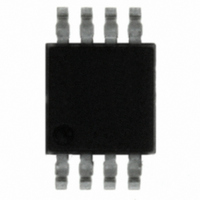ISL83078EIUZA-T Intersil, ISL83078EIUZA-T Datasheet - Page 11

ISL83078EIUZA-T
Manufacturer Part Number
ISL83078EIUZA-T
Description
TXRX ESD RS-485/422 LP 8-MSOP
Manufacturer
Intersil
Type
Transceiverr
Datasheet
1.ISL83076EIBZA-T.pdf
(17 pages)
Specifications of ISL83078EIUZA-T
Number Of Drivers/receivers
1/1
Protocol
RS422, RS485
Voltage - Supply
3 V ~ 3.6 V
Mounting Type
Surface Mount
Package / Case
8-MSOP, Micro8™, 8-uMAX, 8-uSOP,
Lead Free Status / RoHS Status
Lead free / RoHS Compliant
Other names
ISL83078EIUZA-TTR
Available stocks
Company
Part Number
Manufacturer
Quantity
Price
Receivers easily meet the data rates supported by the
corresponding driver, and all receiver outputs (except on the
ISL83071E and ISL83077E) are tri-statable via the active
low RE input.
Driver Features
The RS-485, RS-422 driver is a differential output device
that delivers at least 1.5V across a 54Ω load (RS-485), and
at least 2V across a 100Ω load (RS-422). The drivers feature
low propagation delay skew to maximize bit width, and to
minimize EMI.
All drivers are tri-statable via the active high DE input, except
on the ISL83071E and ISL83077E.
The 250kbps and 500kbps driver outputs are slew rate
limited to minimize EMI, and to reduce reflections in
unterminated or improperly terminated networks. Outputs of
the ISL83076E through ISL83078E drivers are not limited,
so faster output transition times allow data rates of at least
20Mbps.
Hot Plug Function
When a piece of equipment powers up, there is a period of
time where the processor or ASIC driving the RS-485 control
lines (DE, RE) is unable to ensure that the RS-485 Tx and
Rx outputs are kept disabled. If the equipment is connected
to the bus, a driver activating prematurely during power up
may crash the bus. To avoid this scenario, the ISL8307XE
versions with output enable pins incorporate a “Hot Plug”
function. During power up, circuitry monitoring V
that the Tx and Rx outputs remain disabled for a period of time,
regardless of the state of DE and RE. This gives the
processor/ASIC a chance to stabilize and drive the RS-485
control lines to the proper states.
ESD Protection
All pins on these devices include class 3 (>7kV) Human
Body Model (HBM) ESD protection structures, but the
RS-485 pins (driver outputs and receiver inputs)
incorporate advanced structures allowing them to survive
ESD events in excess of ±15kV HBM. The RS-485 pins are
particularly vulnerable to ESD damage because they
typically connect to an exposed port on the exterior of the
finished product. Simply touching the port pins, or
connecting a cable, can cause an ESD event that might
destroy unprotected ICs. These new ESD structures
protect the device whether or not it is powered up, protect
without allowing any latchup mechanism to activate, and
without degrading the RS-485 common mode range of -7V
to +12V. This built-in ESD protection eliminates the need
for board level protection structures (e.g., transient
suppression diodes), and the associated, undesirable
capacitive load they present.
Data Rate, Cables, and Terminations
RS-485, RS-422 are intended for network lengths up to
4000’, but the maximum system data rate decreases as the
transmission length increases. Devices operating at 20Mbps
are limited to lengths less than 100’, while the 250kbps
ISL83070E, ISL83071E, ISL83072E, ISL83073E, ISL83075E, ISL83076E, ISL83077E, ISL83078E
11
CC
ensures
versions can operate at full data rates with lengths of several
thousand feet.
Twisted pair is the cable of choice for RS-485, RS-422
networks. Twisted pair cables tend to pick up noise and
other electromagnetically induced voltages as common
mode signals, which are effectively rejected by the
differential receivers in these ICs.
Proper termination is imperative, when using the 20Mbps
devices, to minimize reflections. Short networks using the
250kbps versions need not be terminated, but, terminations
are recommended unless power dissipation is an overriding
concern.
In point-to-point, or point-to-multipoint (single driver on bus)
networks, the main cable should be terminated in its
characteristic impedance (typically 120Ω) at the end farthest
from the driver. In multi-receiver applications, stubs
connecting receivers to the main cable should be kept as
short as possible. Multipoint (multi-driver) systems require
that the main cable be terminated in its characteristic
impedance at both ends. Stubs connecting a transceiver to
the main cable should be kept as short as possible.
Built-In Driver Overload Protection
As stated previously, the RS-485 spec requires that drivers
survive worst case bus contentions undamaged. These
devices meet this requirement via driver output short circuit
current limits, and on-chip thermal shutdown circuitry.
The driver output stages incorporate short circuit current
limiting circuitry which ensures that the output current never
exceeds the RS-485 spec, even at the common mode
voltage range extremes. Additionally, these devices utilize a
foldback circuit which reduces the short circuit current, and
thus the power dissipation, whenever the contending voltage
exceeds either supply.
In the event of a major short circuit condition, devices also
include a thermal shutdown feature that disables the drivers
whenever the die temperature becomes excessive. This
eliminates the power dissipation, allowing the die to cool. The
drivers automatically re-enable after the die temperature
drops about +15°. If the contention persists, the thermal
shutdown/re-enable cycle repeats until the fault is cleared.
Receivers stay operational during thermal shutdown.
Low Power Shutdown Mode
These CMOS transceivers all use a fraction of the power
required by their bipolar counterparts, but some also include a
shutdown feature that reduces the already low quiescent I
a 10nA trickle. These devices enter shutdown whenever the
receiver and driver are simultaneously disabled (RE = V
and DE = GND) for a period of at least 600ns. Disabling both
the driver and the receiver for less than 50ns guarantees that
the transceiver will not enter shutdown.
Note that receiver and driver enable times increase when the
transceiver enables from shutdown. Refer to Notes 7 through
11, at the end of the “Electrical Specifications” table on page 8
for more information.
June 22, 2007
FN6115.4
CC
CC
to









